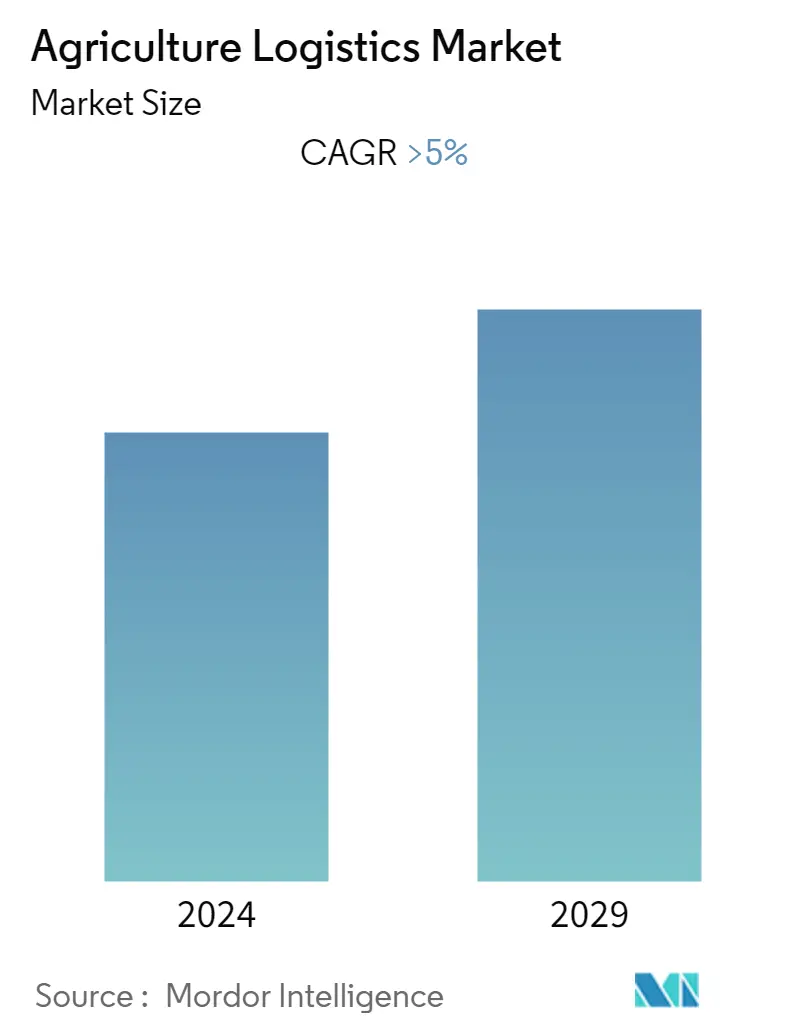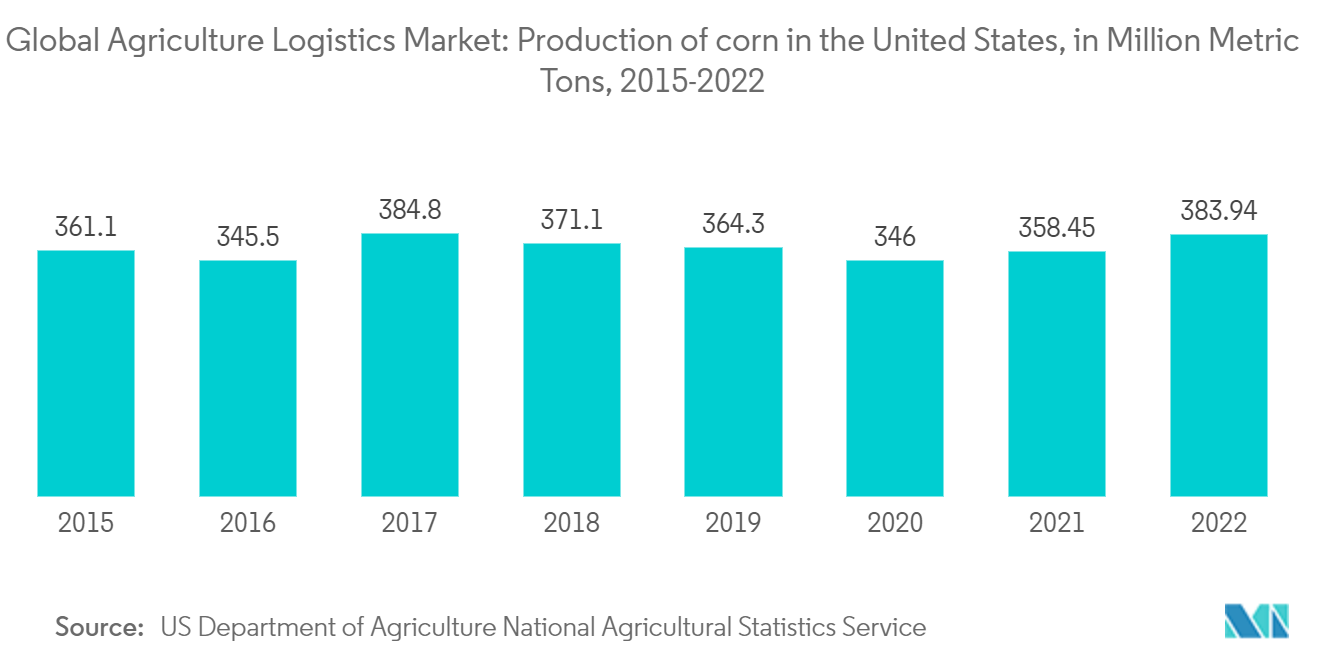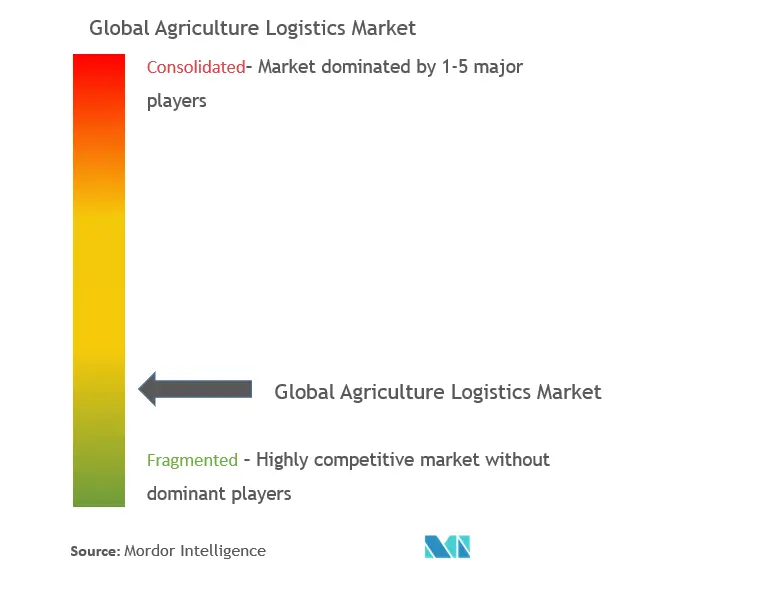Agriculture Logistics Market Size

| Study Period | 2020 - 2029 |
| Base Year For Estimation | 2023 |
| CAGR | 5.00 % |
| Fastest Growing Market | Asia-Pacific |
| Largest Market | Asia-Pacific |
| Market Concentration | Low |
Major Players
*Disclaimer: Major Players sorted in no particular order |
Agriculture Logistics Market Analysis
The Agriculture logistics market is expected to witness a CAGR of more than 5% through the forecast period.
- As the global demand for the agricultural industry is rising consistently, logistics management in the agricultural industry becomes even more vital in ensuring the agricultural production and food supply chain runs smoothly to prevent shortages across the world.
- The COVID-19 pandemic severely impacted the growth of the global agriculture logistics market with supply chain disruptions in the agriculture sector caused as a result of labor shortage, inefficient cold chain facilities, transport restrictions, fluctuations in costs, and lack of collectors. In the post-pandemic period, firms are predicted to focus on end-to-end stock visibility, complex supplier monitoring, and process automation. This will boost the global market trends.
- The decline in agriculture can be seen on developed nations as well, for instance, in US the logistics for agricultural produce which are rural roads remains inefficient due to pending receivables for infrastructure, lack of revenue for maintenance, as per US transportation research group (TRIP), 13% of major rural roads are not under operational condition, with 21% under mediocre, 66% in good condition. Low on workforce bandwidth have made the situation for the agriculture sector worse. There was limited outflow of agricultural produce from California which supplies over third of country's fruits, and vegetables as the number of COVID-19 positive cases piled up.
- Companies such as Ag Growth International (AGI) based out of Canada has suspended its global operations in Italy, India, France, and Brazil as mandated by the government. The effect on the agriculture would be aggravated by decline in the global growth as US GDP has been reduced by USD 1.5 trillion in terms of economic output. This has led to contagion effects by casting reduction in global trade as the Chinese economy suffers the hardest. The relations were on decline since the US-China trade war which also have contributed on to the decline in the agricultural trade.
Agriculture Logistics Market Trends
This section covers the major market trends shaping the Agriculture Logistics Market according to our research experts:
Increasing Importance of Logistics Management in the U.S.’s Largest Crop Production
Corn, the most widely produced crop in the U.S., relies heavily on logistics management to ensure farmers receive the necessary resources to feed the world. But due to various planting seasons, corn is grown in different parts of the world, with a portion of the harvest stored or exported to other countries.
Corn seed in the U.S. is grown from May through November. When harvested, a portion of the yield is used for human and animal consumption while another portion is stored or exported. Stored seeds will be kept for planting in the next viable season in the U.S., while a certain amount is exported to other parts of the world to be planted, so the supply of agricultural seeds is perpetuated. When winter season comes in the U.S., corn is planted in the southern hemisphere, where the season is summer. Just as the U.S. handles corn seeds, countries in the southern hemisphere will dedicate a part for consumption and another part for planting in the next viable season or export it back to the U.S. to be planted.
Effective logistics management is essential for corn production since the crop is one of the major contributors to feeding livestock and manufacturing industrial products, food, beverages, etc. Corn also plays a significant role in combating the rising price of petroleum since it is a major component of ethanol, a viable alternative to petroleum. Corn was America's largest grown crop in 2019, with the U.S. farmers planting 91.7 million acres of corn.

Growing Cold Storage and Refrigerated Warehouses Market Worldwide for Agriculture Sector
With increasing Fast-Moving Consumer Goods (FMCG) and Agro sales in the current scenario, the need for cold storage warehouses has been rapidly increasing. Several warehouses comprising cold chain systems are usually designed to ensure the ideal storage and transportation conditions for temperature-sensitive products. The global cold chain logistics market was worth almost 160 billion U.S. dollars in 2018 and is expected to exceed USD 500 billion by 2025. Cold chain logistics involves the transportation of temperature-controlled products along a supply chain using refrigerated packaging solutions to preserve the quality of products such as fresh agricultural goods, seafood, frozen food, or pharmaceutical products. Multiple export industries are dependent on the vital links that cold chain solutions provider. Businesses invest millions of dollars in their cold chain operations to create effective, efficient, and reliable processes, as end-to-end cold chain security is the weak link in the system. A single breakdown in the cold chain logistics chain can lead to catastrophic losses of products and capital. Globally, the number of refrigerated warehouses is increasing owing to a surge in demand for agriculture and pharmaceutical products, which in turn is boosting the Asia-Pacific cold chain logistics statistics. The total capacity of refrigerated warehouses worldwide amounted to 616 million cubic meters in that year and has grown since. In 2020, the United States had the largest capacity of refrigerated warehousing in the world, with 156 million cubic meters. The total capacity of refrigerated warehouses worldwide amounted to 719 million cubic meters in that year.

Agriculture Logistics Industry Overview
The Global Agriculture logistics market is fragmented in nature, with a mix of global and regional players. The market is expected to grow during the forecast period due to several factors such as e-commerce, technology integration, and growing economies. The major companies in the country have adopted various modern technologies, such as warehousing management systems, automation, drone delivery, and the transportation management system, which has enabled better planning and tracking facilities, resulting in increased productivity and increased value proposition. Some of the major Players Include DHL, Kuehne+Nagel AG, Fed Ex, CEVA Logistics, and United Parcel Services are among others.
Agriculture Logistics Market Leaders
-
DHL
-
CEVA Logistics
-
Kuehne+Nagel International AG
-
Bollore Logistics
-
Fedex
*Disclaimer: Major Players sorted in no particular order

Agriculture Logistics Market News
- January 2023: Deutsche Post DHL Group announced a USD 137 million investment plan for the U.S. domestic and cross-border e-commerce market. The Group's objective is to exploit the global B2C e-commerce market for shipments crossing borders which is expected to grow from USD 400 billion in 2022 to a total global volume of USD 1 trillion in 2020.
- June 2022: CEVA Logistics opened a new 14,000-square-meter facility in the Philippines earlier this month, as the company looks to enhance its capabilities for the Southeast Asian market. The warehouse will serve the electronics and F&B sector with a full range of warehousing, distribution, and value-added services, including picking and packing, labeling, bundling, re-work, tax stamping, and digital bottle printing.
Agriculture Logistics Market Report - Table of Contents
1. INTRODUCTION
- 1.1 Study Assumptions
- 1.2 Scope of the Study
2. RESEARCH METHODOLOGY
3. EXECUTIVE SUMMARY
4. MARKET INSIGHTS
- 4.1 Current Market Scenario
- 4.2 Government Regulations and Initiatives
- 4.3 Technological Trends in the Market
- 4.4 Insights into the E-commerce Industry
- 4.5 Insights into Supply Chain Planning In Agricultural Logistics
- 4.6 Insights into the Courier, Express, and Parcel Industry (CEP)
- 4.7 Industry Value/Supply Chain Analysis
- 4.8 Impact of COVID-19 on the Market
5. MARKET DYNAMICS
- 5.1 Market Drivers
- 5.2 Market Restraints
- 5.3 Market Opportunities
-
5.4 Porter's Five Forces Analysis
- 5.4.1 Bargaining Power of Suppliers
- 5.4.2 Bargaining Power of Consumers/Buyers
- 5.4.3 Threat of New Entrants
- 5.4.4 Threat of Substitute Products
- 5.4.5 Intensity of Competitive Rivalry
6. MARKET SEGMENTATION
-
6.1 By Service
- 6.1.1 Transportation
- 6.1.2 Warehousing
- 6.1.3 Value-added Services
-
6.2 By End-User
- 6.2.1 Small and Medium Enterprises (SMEs)
- 6.2.2 Large Enterprises
-
6.3 By Geography
- 6.3.1 North America
- 6.3.1.1 United States
- 6.3.1.2 Canada
- 6.3.1.3 Mexico
- 6.3.2 Europe
- 6.3.2.1 Germany
- 6.3.2.2 France
- 6.3.2.3 United Kingdom
- 6.3.2.4 Rest of Europe
- 6.3.3 Asia-Pacific
- 6.3.3.1 China
- 6.3.3.2 Japan
- 6.3.3.3 SouthKorea
- 6.3.3.4 India
- 6.3.3.5 Rest of Asia-Pacific
- 6.3.4 LAMEA
- 6.3.4.1 Brazil
- 6.3.4.2 South Africa
- 6.3.4.3 GCC
- 6.3.4.4 Rest of LAMEA
7. COMPETITIVE LANDSCAPE
- 7.1 Overview (Market Concentration and Major Players)
-
7.2 Company Profiles
- 7.2.1 DHL
- 7.2.2 Kuehne + Nagel International AG
- 7.2.3 Bollore Logistics
- 7.2.4 Blue Yonder
- 7.2.5 Nippon Express Co., Ltd.
- 7.2.6 The Maersk Group
- 7.2.7 C.H. Robinson
- 7.2.8 CEVA Logistics
- 7.2.9 FedEx Corp.
- 7.2.10 United Parcel Service
- *List Not Exhaustive
8. FUTURE OUTLOOK OF THE MARKET
9. APPENDIX
** Subject To AvailablityAgriculture Logistics Industry Segmentation
Agrologistics is a relatively new interdisciplinary field in the agricultural sector, including the. management of supply chains of agricultural products and raw materials from production to delivery to the consumer, combining agricultural production, marketing, management, and logistics.
Global Agriculture Logistics Market is Segmented by Service (Transportation, Warehousing, and Value-added Services), By End-User (Small and Medium Enterprises (SMEs), and Large Enterprises), By Geography (North America (US, Canada, Mexico), Europe (Spain, Germany, France, UK, Italy and Rest of Europe), Asia-Pacific (China, Japan, South Korea, India, Rest of Asia-Pacific), LAMEA (Brazil, Argentina, South Africa, Morocco, GCC, Rest of LAMEA)). The report offers market size and forecast values (USD billion) for all the above segments.
| By Service | Transportation | |
| Warehousing | ||
| Value-added Services | ||
| By End-User | Small and Medium Enterprises (SMEs) | |
| Large Enterprises | ||
| By Geography | North America | United States |
| Canada | ||
| Mexico | ||
| By Geography | Europe | Germany |
| France | ||
| United Kingdom | ||
| Rest of Europe | ||
| By Geography | Asia-Pacific | China |
| Japan | ||
| SouthKorea | ||
| India | ||
| Rest of Asia-Pacific | ||
| By Geography | LAMEA | Brazil |
| South Africa | ||
| GCC | ||
| Rest of LAMEA |
Agriculture Logistics Market Research FAQs
What is the current Agriculture Logistics Market size?
The Agriculture Logistics Market is projected to register a CAGR of greater than 5% during the forecast period (2024-2029)
Who are the key players in Agriculture Logistics Market?
DHL, CEVA Logistics, Kuehne+Nagel International AG, Bollore Logistics and Fedex are the major companies operating in the Agriculture Logistics Market.
Which is the fastest growing region in Agriculture Logistics Market?
Asia-Pacific is estimated to grow at the highest CAGR over the forecast period (2024-2029).
Which region has the biggest share in Agriculture Logistics Market?
In 2024, the Asia-Pacific accounts for the largest market share in Agriculture Logistics Market.
What years does this Agriculture Logistics Market cover?
The report covers the Agriculture Logistics Market historical market size for years: 2020, 2021, 2022 and 2023. The report also forecasts the Agriculture Logistics Market size for years: 2024, 2025, 2026, 2027, 2028 and 2029.
Agriculture Logistics Industry Report
Statistics for the 2024 Agriculture Logistics market share, size and revenue growth rate, created by Mordor Intelligence™ Industry Reports. Agriculture Logistics analysis includes a market forecast outlook to 2029 and historical overview. Get a sample of this industry analysis as a free report PDF download.



